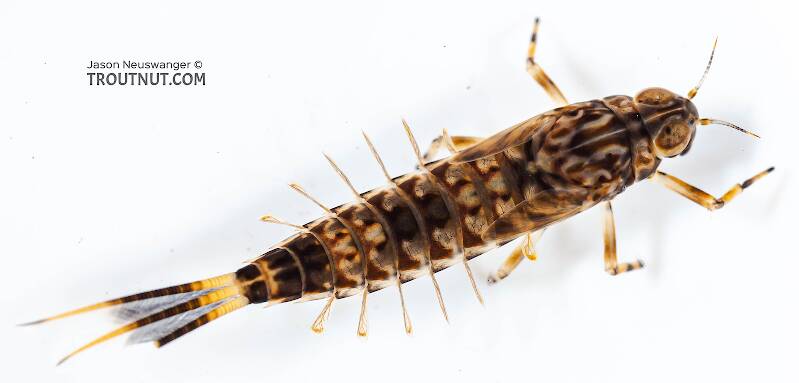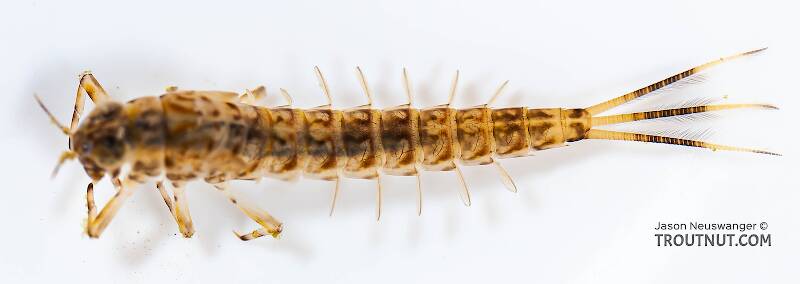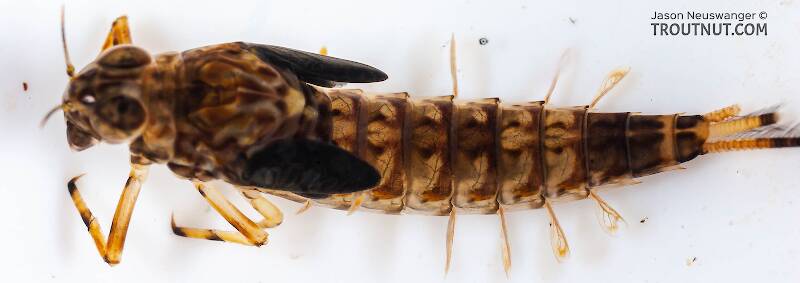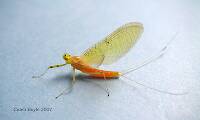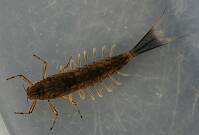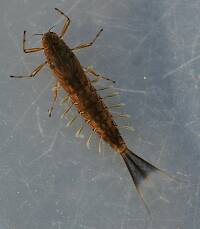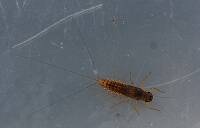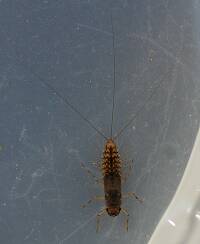
Hex Mayflies
Hexagenia limbata
The famous nocturnal Hex hatch of the Midwest (and a few other lucky locations) stirs to the surface mythically large brown trout that only touch streamers for the rest of the year.
Featured on the forum

This specimen keys pretty easily to Onocosmoecus, and it closely resembles a specimen from Alaska which caddis expert Dave Ruiter recognized as this genus. As with that specimen, the only species in the genus documented in this area is Onocosmoecus unicolor, but Dave suggested for that specimen that there might be multiple not-yet-distinguished species under the unicolor umbrella and it would be best to stick with the genus-level ID. I'm doing the same for this one.

Troutnut is a project started in 2003 by salmonid ecologist Jason "Troutnut" Neuswanger to help anglers and
fly tyers unabashedly embrace the entomological side of the sport. Learn more about Troutnut or
support the project for an enhanced experience here.
This topic is about the Mayfly Species Ameletus ludens
This mayfly, which occasionally produces fishable hatches, is interesting because it's one of the only mayflies capable of parthenogenesis.Example specimens
Konchu on Apr 25, 2009April 25th, 2009, 3:52 pm EDT
Has anyone else watched a Brown Dun hatch or swarm? If so, what time of day did you see it, and how long did it last?
I came upon a woodland swarm late this evening. I thought I saw mating occurring higher above the stream. This would mean that parthenogenesis is not necessarily happening in "my" stream. I watched for awhile, but got distracted (venomous snake). I hope to catch it (the hatch, not the snake) again tomorrow night and note the egg-laying behavior and possibly nab some male adults for science. There's a range of nymph ages, so I should be OK, weather permitting.
I came upon a woodland swarm late this evening. I thought I saw mating occurring higher above the stream. This would mean that parthenogenesis is not necessarily happening in "my" stream. I watched for awhile, but got distracted (venomous snake). I hope to catch it (the hatch, not the snake) again tomorrow night and note the egg-laying behavior and possibly nab some male adults for science. There's a range of nymph ages, so I should be OK, weather permitting.
GONZO on Apr 27, 2009April 27th, 2009, 8:38 am EDT
Hi Konchu,
Brown Duns are pretty insignificant on the streams that I've fished, but I'm curious to know how your collecting efforts turned out. Your question also set me to looking at male/female eye size differences in photographs of Ameletus nymphs. In the photos of browni, tertius, and some unidentified Western species, I can find male/female differences. (In the case of tertius, there was also a photo of a male dun reared from an identified nymph.) However, in photos of ludens (including Jason's) and a fairly long series of lineatus, I only see females. Did you happen to notice any eye size differences in the nymphs you looked at on your stream? I assume that ludens and lineatus are closely related, but is lineatus also known to be parthenogenetic? Just curious....
Brown Duns are pretty insignificant on the streams that I've fished, but I'm curious to know how your collecting efforts turned out. Your question also set me to looking at male/female eye size differences in photographs of Ameletus nymphs. In the photos of browni, tertius, and some unidentified Western species, I can find male/female differences. (In the case of tertius, there was also a photo of a male dun reared from an identified nymph.) However, in photos of ludens (including Jason's) and a fairly long series of lineatus, I only see females. Did you happen to notice any eye size differences in the nymphs you looked at on your stream? I assume that ludens and lineatus are closely related, but is lineatus also known to be parthenogenetic? Just curious....
Konchu on Apr 27, 2009April 27th, 2009, 3:22 pm EDT
I found the swarm again, but I wound up concluding that nothing I found would be of interest here. By posting, I was hoping to gain some info to help me study the species that also might be of some biological benefit to someone trying to match that hatch.
We can discuss some of nitty gritty details of Ameletus eye morphology, etc., via PM (for a number of reasons).
We can discuss some of nitty gritty details of Ameletus eye morphology, etc., via PM (for a number of reasons).
Taxon on Apr 27, 2009April 27th, 2009, 6:10 pm EDT
Oh shoot. National security, again. Seriously, this is information that I would really like to see (hear, whatever), and I'd be willing to bet that I know at least one other individual who would as well.
Martinlf on Apr 28, 2009April 28th, 2009, 1:34 am EDT
Me too, Konchu. If we have threads for "Just Fishing for Trout," why can't we have them for serious discussions about entomology also? I don't always follow all the details, especially when Taxon starts talking dirty about gender (Sorry Roger, couldn't resist)--but I've learned a lot from those who know more about bugs than I do.
"He spread them a yard and a half. 'And every one that got away is this big.'"
--Fred Chappell
--Fred Chappell
Konchu on Apr 28, 2009April 28th, 2009, 8:30 am EDT
OK. I guess there's at least a handful of interested people and probably no reason to play cards so close to my chest. Plus my mood changed. :} WARNING: Someone with a PhD will be using latinized words. If you find this offensive, stop reading now!
First, the swarm turned out to be another species (of flat-headed mayflies) that probably came from some distance downstream. I felt like a bit of a doofus when I found this, but the thing swarmed at late dusk, and Ameletus was the only species of that size ready to emerge from my stream. Goes to show that you can't always match the hatch based on the nymphs that you find where you are standing.
Secondly, the eyes were mostly the same size among the larvae I checked out. My sample size was pretty small because I threw most back, knowing the species already. Sometimes a better way to sex them is to look at the posterior abdominal sternites. Often, you can see shapes that remind you of male or female.
Third, the male adult of lineatus is not known to me. I am not sure if ANYONE has ever seen it. Thus, lineatus is possibly a obligately parthenogenetic species. A couple of male adults of the closely related ludens (thus facultatively parthenogenetic) have been reported, but there are some questions about these among certain entomological circles. Further, there are those who consider the distinction between lineatus and ludens to be doubtful, but the two seem separable to me.
I am working to obtain additional molecular data to explore some of these issues.
First, the swarm turned out to be another species (of flat-headed mayflies) that probably came from some distance downstream. I felt like a bit of a doofus when I found this, but the thing swarmed at late dusk, and Ameletus was the only species of that size ready to emerge from my stream. Goes to show that you can't always match the hatch based on the nymphs that you find where you are standing.
Secondly, the eyes were mostly the same size among the larvae I checked out. My sample size was pretty small because I threw most back, knowing the species already. Sometimes a better way to sex them is to look at the posterior abdominal sternites. Often, you can see shapes that remind you of male or female.
Third, the male adult of lineatus is not known to me. I am not sure if ANYONE has ever seen it. Thus, lineatus is possibly a obligately parthenogenetic species. A couple of male adults of the closely related ludens (thus facultatively parthenogenetic) have been reported, but there are some questions about these among certain entomological circles. Further, there are those who consider the distinction between lineatus and ludens to be doubtful, but the two seem separable to me.
I am working to obtain additional molecular data to explore some of these issues.
GONZO on Apr 28, 2009April 28th, 2009, 11:17 am EDT
Thank you very much for answering my questions, Konchu. Although some might think this has little to do with fly fishing, I've already found an interesting (if circuitous) connection to this discussion. Investigation of information about other mayfly parthenogens led me to mention of a parthenogenetic Serratella species discovered (by fly fishers) on the Frying Pan in CO. This species displays abdominal bursting in the (female) dun. I don't know if I'll ever get to fish the Pan during the time of this Serratella emergence, but I'd relish tying (and fishing) an imitation of the "Gut-Busting Dun." :)
Konchu on Apr 28, 2009April 28th, 2009, 4:43 pm EDT
As an aside, I saw some of these when I was "up north". These female adults resemble something between Ephemerella tibialis (formerly in Serratella) and Matriella teresa (formerly in Serratella and Ephemerella).
Troutnut on Apr 28, 2009April 28th, 2009, 8:57 pm EDT
A couple of male adults of the closely related ludens (thus facultatively parthenogenetic) have been reported, but there are some questions about these among certain entomological circles.
Questions among certain circles? That sounds intriguing. Are they not convinced the males were fully male or something?
Jason Neuswanger, Ph.D.
Troutnut and salmonid ecologist
Troutnut and salmonid ecologist
Falsifly on Apr 29, 2009April 29th, 2009, 2:44 pm EDT
Just curious guys, is the offspring produced through parthenogenesis a genetic clone or are there individual specific traits?
Falsifly
When asked what I just caught that monster on I showed him. He put on his magnifiers and said, "I can't believe they can see that."
When asked what I just caught that monster on I showed him. He put on his magnifiers and said, "I can't believe they can see that."
Troutnut on Apr 29, 2009April 29th, 2009, 8:30 pm EDT
Well, I'm not a geneticist, but my understanding is that it produces a clone. Mutations should still occur, meaning each one is a little bit different from its parent, but I think it would be comparable to the difference between identical twins... not usually noticeable.
Jason Neuswanger, Ph.D.
Troutnut and salmonid ecologist
Troutnut and salmonid ecologist
Quick Reply
Related Discussions
Topic
Replies
Last Reply
3
Sep 4, 2012
by Entoman
by Entoman


